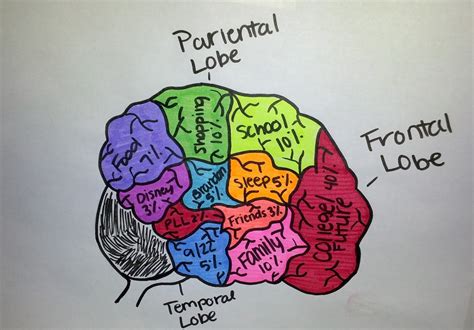Introduction
The AP Psych Brain Project is a comprehensive endeavor that delves into the intricate workings of the human brain, exploring its structure, function, and role in shaping our thoughts, emotions, and behaviors. This multifaceted project provides students with a unique opportunity to investigate the complex processes that govern our mental processes, offering invaluable insights into the fascinating landscape of neuroscience.

Structure of the Brain
The brain, the central command center of our body, is composed of billions of neurons that communicate through electrical and chemical signals. Its intricate structure comprises various regions, each with specialized functions:
- Cerebrum: The largest part of the brain, responsible for higher-order cognitive functions such as language, reasoning, and decision-making.
- Cerebellum: Coordinates movement and balance, ensuring smooth and coordinated muscular actions.
- Brainstem: Controls vital life functions, including breathing, heart rate, and sleep-wake cycles.
- Limbic System: Involved in emotions, memory, and motivation, forming the core of our emotional experiences.
Functions of the Brain
The human brain is a marvel of complexity, performing an astonishing array of functions that enable us to interact with the world and regulate our internal processes:
- Cognitive Functions: Includes attention, memory, learning, language, and problem-solving, providing the foundation for our intellectual abilities.
- Emotional Functions: Regulates emotions, motivations, and drives, influencing our subjective experiences and behaviors.
- Motor Functions: Controls voluntary and involuntary movements, enabling us to interact physically with our environment and express our emotions.
- Sensory Functions: Processes sensory information from the body and external stimuli, allowing us to perceive the world around us.
Applications of Neuroscience
Neuroscience, the study of the brain and nervous system, has far-reaching applications across various disciplines, including medicine, education, and psychology. Its insights into the human mind have led to advancements in:
- Mental Health Treatment: Improved understanding of mental disorders, leading to more effective diagnoses and therapies.
- Educational Techniques: Enhanced learning methods based on how the brain processes and retains information.
- Cognitive Enhancement: Development of neurotechnologies and therapies aimed at improving cognitive abilities and treating age-related decline.
- Brain-Computer Interfaces: Advancements in technology that allow for direct communication between the brain and external devices, facilitating novel applications in rehabilitation and communication.
Tables for Data Analysis
Table 1: Brain Regions and Functions
| Brain Region | Function |
|---|---|
| Cerebrum | Higher-order cognitive functions (e.g., language, reasoning) |
| Cerebellum | Coordination of movement and balance |
| Brainstem | Vital life functions (e.g., breathing, heart rate) |
| Limbic System | Emotions, memory, motivation |
Table 2: Neurotransmitters and their Effects
| Neurotransmitter | Effects |
|---|---|
| Dopamine | Pleasure, reward, motivation |
| Serotonin | Mood regulation, sleep |
| GABA | Calming, anxiety reduction |
| Glutamate | Learning, memory |
Table 3: Key Findings from Neuroscience Research
| Finding | Implication |
|---|---|
| Plasticity of the brain | Ability to learn and adapt throughout life |
| Influence of genes and environment on brain development | Importance of both nature and nurture |
| Impact of stress on cognition and mental health | Need for stress management strategies |
| Role of emotions in decision-making | Cognitive biases influenced by emotional responses |
Table 4: Ethical Considerations in Neuroscience
| Ethical Concern | Considerations |
|---|---|
| Privacy of brain data | Protection of sensitive information |
| Informed consent for research participation | Transparency and subject well-being |
| Potential risks of brain-computer interfaces | Responsible use and regulation |
| Equitable access to neurotechnologies | Ensuring fair distribution of benefits |
Pros and Cons of Neurotechnology
Neurotechnology, which involves the development and application of devices and therapies that interact directly with the brain, offers both advantages and disadvantages:
Pros:
- Improved treatment options for mental disorders
- Enhanced cognitive abilities
- Innovative communication methods
Cons:
- Privacy and security concerns
- Potential for misuse
- Ethical implications regarding the mind’s autonomy
Imaginative Application of Neuroscience: Neurogaming
Neurogaming, a burgeoning field at the intersection of neuroscience and gaming, leverages brain-computer interfaces to allow for games that respond directly to brain activity. This novel application offers:
- Enhanced Immersion: Games that engage the player’s brainwaves, providing a more immersive and interactive experience.
- Cognitive Training: Neurogames can incorporate cognitive challenges, offering a playful way to improve attention, memory, and other cognitive functions.
- Mental Health Therapy: Neurogaming holds potential as a therapeutic tool, providing engaging and personalized interventions for mental disorders.
Conclusion
The AP Psych Brain Project provides an invaluable platform for exploring the intricate depths of the human brain. By investigating its structure, functions, and applications, students gain a profound understanding of the complexities that govern our thoughts, emotions, and behaviors. This exploration not only enhances academic knowledge but also fosters a fascination with the wonders of the human mind. As neuroscience continues to evolve, we can anticipate groundbreaking discoveries that will reshape our understanding of ourselves and unlock limitless possibilities for the future.
